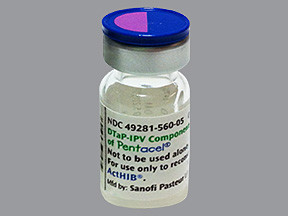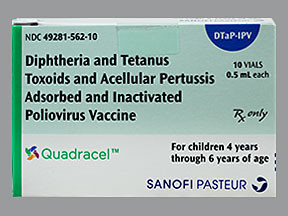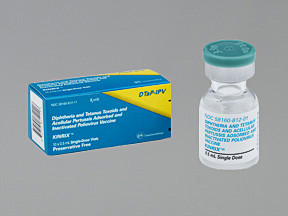DIPHTHERIA/TETANUS/PERTUSSIS/POLIO VACCINE - INJECTION
PHONETIC PRONUNCIATION: (dip-THEER-ee-uh/TET-un-us/per-TUSS-iss/ POE-lee-oh)
COMMON BRAND NAME(S): Kinrix, Quadracel
GENERIC NAME(S): diphtheria, pertussis(acell),tetanus,polio vaccine/PF
Uses
USES: This medication is a combination of vaccines against diphtheria, tetanus (lockjaw), pertussis (whooping cough), and polio. Vaccination is the best way to protect against these life-threatening infections. Vaccines work by causing the body to produce its own protection (antibodies). Vaccines may not fully protect everyone who receives them.
How to use DIPHTHERIA/TETANUS/PERTUSSIS/POLIO VACCINE - INJECTION
HOW TO USE: Read all vaccine information available from your health care professional before receiving the vaccine. If you have any questions, ask your health care professional. This vaccine is injected into a muscle by a health care professional. It is usually given in the thigh or upper arm. Vaccines are usually given in a series of doses to provide the best protection. Closely follow the vaccination schedule provided by the health care professional. Keep all scheduled medical appointments. It may be helpful to mark a calendar as a reminder. There are various combinations of vaccines available. Discuss the risks and benefits of vaccination with the health care professional.
Side Effects
Precautions
Interactions
Overdose
Images
Reviews
Faq for DIPHTHERIA/TETANUS/PERTUSSIS/POLIO VACCINE - INJECTION
The diphtheria/tetanus/pertussis/polio vaccine is a combination vaccine that protects against four different diseases: diphtheria, tetanus, pertussis (whooping cough), and polio. It is administered through an injection.
These diseases can cause severe illness, complications, and even death. Vaccination helps protect individuals and communities from these harmful diseases by stimulating the immune system to produce antibodies.
Typically, a series of five doses is recommended for full protection. The first three doses are given in infancy, followed by a booster shot between the ages of 4-6 years, and another booster shot at 11-12 years of age.
Common side effects include pain, redness, swelling, or tenderness at the injection site. Some individuals may experience mild fever, fatigue, headache, or muscle pain. Severe allergic reactions are extremely rare.
The vaccine provides long-term protection against diphtheria, tetanus, pertussis, and polio. However, booster doses are required throughout life to maintain immunity.
People who have had a severe allergic reaction to a previous dose or any component of the vaccine should not receive it. It is recommended to consult with a healthcare provider before getting vaccinated if you have certain medical conditions.
Yes, it is safe to receive other vaccines at the same time as this combination vaccine. Numerous studies have shown that simultaneous administration of multiple vaccines is generally safe and does not increase the risk of adverse effects.
Yes, the vaccine is considered safe during pregnancy and is often recommended to protect both the mother and baby from these diseases. It is typically administered during the second or third trimester.
There are generally no restrictions on travel after receiving the vaccine. However, it is advisable to consult with a healthcare provider regarding specific travel recommendations and requirements for the region you plan to visit.
Disclaimer
IMPORTANT: HOW TO USE THIS INFORMATION: This is a summary and does NOT have all possible information about this product. This information does not assure that this product is safe, effective, or appropriate for you. This information is not individual medical advice and does not substitute for the advice of your health care professional. Always ask your health care professional for complete information about this product and your specific health needs.





No Reviews Yet